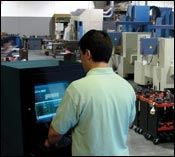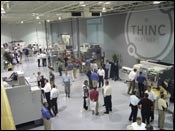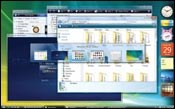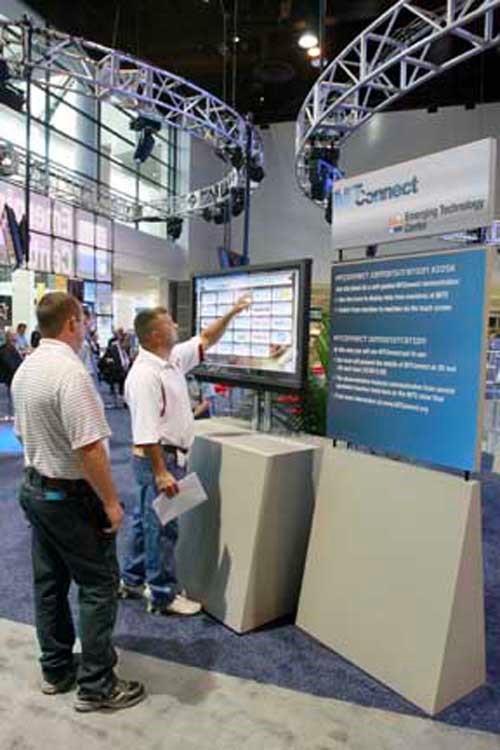Thinking About Shopfloor Interoperability-And Making It Happen
The significance of “plug-and-produce” integration for machine shops and manufacturing plants becomes clear from the perspective of an ERP software developer.
Share







Autodesk, Inc.
Featured Content
View More


.png;maxWidth=45)
DMG MORI - Cincinnati
Featured Content
View More“Plug and play” is the term used in the consumer electronics industry to assure customers that their new DVD players, video games, photo printers and so on, will work without a lot of setup or installation hassles as soon as they are hooked up. The Sony will work with the Hitachi. The HP will work with the Dell. Manufacturing plants and machine shops would like to have the same ease and assurance when attempting to integrate machine tool CNCs, measurement systems, tool presetters, data collection devices and other digital systems. For them, “plug and produce” would be the industrial version of the plug-and-play concept. As it stands today, shops and plants usually have difficulty with connecting different manufacturing systems in a way that allows manufacturing data to be shared, processed and used to improve productivity.
Several initiatives are afoot to relieve this situation. They promise to bring a new era of “interoperability” to the metalworking industry. The goal is to better enable digital devices and systems to “talk to each other” automatically on the shop floor and communicate with decision makers in the front office. “Interoperability” means that the systems can be connected effectively even though different developers and suppliers are involved.
One of these initiatives is the Partners in THINC program sponsored by Okuma America Corp. This program is designed to take advantage of the open architecture of the company’s THINC-OSP control for CNC machines. “Open architecture” means that the structure of this control’s hardware and software allows other systems to be interfaced to it. For example, the control uses USB ports like those on laptop computers, digital cameras, printers and so on to make a physical connection between the CNC and external devices. Likewise, the CNC’s software includes an applications programming interface (API) that makes its databases and processing functions accessible to software applications running in the external devices. Thus, signals indicating that a machine has completed its cycle, let’s say, can be passed to any compliant device that needs an accurate, on-time count of finished parts.
The most prominent development in this initiative is the Partners in THINC facility in Charlotte, North Carolina. Essentially, it’s a large showroom where the company can demonstrate how various systems from other developers of manufacturing technology can link to the THINC control and to one another. These developers are the “partners” in the program. To participate, these partners must be committed to the collaborative spirit behind this initiative. Partners must provide equipment as well as help staff the facility with their personnel. The facility is meant to function as a production center that machines real customer parts to show how the integrated systems improve and streamline operations.
A Bridge
One of the partners is the JobBoss unit of Exact Software (Minneapolis, Minnesota). JobBoss is an enterprise resource planning (ERP) application—that is, software designed to help managers monitor, control and optimize activities on the factory floor. This software includes modules for quoting and estimating, preparing shop routers and bills of material, scheduling, costing and other business management/accounting functions.
It is useful to look at shopfloor integration in general and Okuma’s THINC approach in particular from the perspective of an ERP developer. ERP is, literally and figuratively, a focal point that clarifies why interoperability and integration are critical objectives for manufacturing enterprises. “ERP plays a unique role in a manufacturing company,” explains Dan Deanovic, director of product development for Exact JobBoss. “It’s the bridge between the factory floor and the front office. Integrating the machine tool CNC with other shopfloor manufacturing devices helps all of these systems run more efficiently, whereas integrating the CNC with an ERP system ultimately helps the entire enterprise run more efficiently.”
That’s because, he says, ERP not only gathers and shares shopfloor data but also organizes that data into information that help managers make better decisions. “It’s logical for the machine tool CNC to act as a hub for the other manufacturing applications to which it is integrated,” Mr. Deanovic says. “It’s also logical for the ERP system to carry this integration to the enterprise-wide level.”
Start With Automated Data Collection
Like all ERP systems, JobBoss needs information from the shop floor. This information must be entered into databases that the software can read. Data entry can be manual or automated to varying degrees. With no automation, operators can simply turn in reporting slips at the end of the shift. Operators with handheld keypads or bar code scanners connected to a shop network can make this reporting a push-button affair. Some operator intervention is required, but this method is quicker, timelier and less prone to error. The next step is full automation, which requires integration with the CNC. This is a logical next step because most of the information entered by the operator is based on what is displayed on the machine tool CNC.
“The ideal situation is to have the CNC communicate automatically with the ERP system via a shop network,” Mr. Deanovic says. Most shops already have a network in place for downloading NC part programs, so getting this information to the host computer is not a problem. Connecting and “talking” to the CNC was the difficult part.
“Older CNCs are often closed systems, so there is no easy way to interface outside data collection devices,” Mr. Deanovic explains. “Open architecture on the CNC makes the interface possible. However, a well-developed API on the CNC can make this interface easy. Okuma’s API is designed to do that,” he says.
“We had to write a small software application that runs on the CNC. That lets it communicate with the JobBoss application automatically,” Mr. Deanovic says. According to Mr. Deanovic, the ERP system had its own public interface, so it was already designed to accept data coming from other sources besides traditional data collection systems. JobBoss was “already halfway there” to start, so to speak. “We use Web service technology, a widely-adopted method to process transactions and allow different types of software applications to talk to each other over an intranet or Internet, without human intervention. The data coming off the CNC is formatted in XML, a generic format used to transfer data, and is processed by the Web service on the JobBoss side.”
This is not the first time that this ERP system has been interfaced with a CNC. However, establishing this interface with the THINC-OSP control went smoothly because Okuma America facilitated this process. “Their software technicians were very willing to modify or expand their API to accommodate integration requirements from any of the Partners in THINC.”
Interfacing the CNC to the ERP system eliminates the need for the operator to enter any data. For example, a shop in Minneapolis has installed this interface. The THINC-OSP controls on the shop’s two Okuma lathes report directly to the JobBoss host computer. The shop manager is pleased because he gets better data with no delays and his operators are not tied up with the administrative task of reporting labor time.
CNC As A Hub
The next step is where the possibilities get exciting, Mr. Deanovic says. As he points out, an ERP system creates value by organizing data into useful information for decision makers. The quicker this information gets to decision makers, the more effective the decisions will be.
This means that an ERP system can magnify the benefits of shopfloor integration when connected to a CNC that acts as a hub linking other systems with useful information to share.
One of the projects that JobBoss is proposing illustrates this synergy. Data that is usually beyond the reach of an ERP system can be automatically accessed and incorporated into reports of vital interest to shop managers. For example, shop managers always want accurate and complete job costs. Some costs, however, are hard to determine, so shops typically use estimates or don’t account for them at all. Mr. Deanovic believes that capturing more accurate and complete cost figures is within grasp when manufacturing solutions are integrated on the shop floor. This integration can enable an ERP system to give managers a clearer picture of “where their money is going,” he says.
Here’s one scenario as it might play out at the THINC facility. Currently, a Kennametal tool inventory system and a Zoller presetter are connected to the CNC on an Okuma Captain L370 lathe. ToolBoss, the tool inventory system, keeps track of the location, inventory count and cost of all inserts, cutter bodies, toolholders and other components that are assembled when needed for a particular part number. The presetter provides dimensional data about the assembled tool, such as tool radius, length, runout and other measurements or conditions. When a cutting tool is loaded at the machine, its unique identification number links it with data about its specific attributes. These figures can be retrieved automatically when the tool is called up as the operator prepares to run the job. For example, tool length compensation tables can be loaded without additional data entry. Likewise, after running the job, the CNC reports tool life data for tracking by the tool data management system maintained by ToolBoss.
This integration benefits shopfloor operations by eliminating redundant data entry, avoiding human error and freeing up the operator for other tasks. The ERP system can also access and analyze tooling data for functions such as cost reporting. Tool consumption can be allocated to the part or job based on actual time in the cut. If a $15 insert expected to last 60 minutes is used for a finishing operation that takes 2 minutes for each part, the exact cost can be calculated for that operation. Similar costs for all operations can be combined and reported. Likewise, the tool management system can keep track of remaining life for that insert and allocate usage costs to further jobs until its expected life is fully consumed. The bottom line for the shop owner is more accurate, complete and timely job cost.
Because the tool inventory system and the presetter are already interfaced with the CNC, integrating with the ERP system is a manageable task, Mr. Deanovic says. “For one thing, the framework for collaboration between JobBoss, Kennametal and Zoller is already in place. For another, we can build on completed development efforts. Each of the parties involved doesn’t have to do a lot of extra work to make changes or additions needed to establish this data exchange,” he says.
Master Coordinator
Being able to reach the individual machine tool is the real power of an ERP system such as JobBoss, Mr. Deanovic says. “ERP is positioned to be the master coordinator that delivers information to management. As more and more manufacturing solutions can be integrated through the machine tool CNC, this coordination function becomes more and more valuable.” The impact of tying manufacturing solutions together becomes visible through the ERP system, he says.
It also works in the other direction. When managers have detailed reports coming from the shop floor, they can exert a stronger positive influence on shopfloor activities. Quickly spotting a cutting tool that is performing better or worse than expected represents an opportunity to exploit or a problem to resolve, for example. And that is just the tip of the iceberg, Mr. Deanovic says.
The tactical value of integrating manufacturing solutions on the shop floor is clear to personnel working there. However, because an ERP system is the bridge between the shop floor and the front office, it elevates this integration to the strategic level. Monitoring and controlling the shop floor become linked to the corporate goals of the manufacturing enterprise.
This linkage should drive the demand for easier shopfloor integration. “Plug-and-produce” is more than a shopfloor imperative. Plugging into a well-connected CNC via an ERP system promises to make the whole shop or plant more productive.
Related Content
4 Commonly Misapplied CNC Features
Misapplication of these important CNC features will result in wasted time, wasted or duplicated effort and/or wasted material.
Read MoreOrthopedic Event Discusses Manufacturing Strategies
At the seminar, representatives from multiple companies discussed strategies for making orthopedic devices accurately and efficiently.
Read MoreThe Power of Practical Demonstrations and Projects
Practical work has served Bridgerland Technical College both in preparing its current students for manufacturing jobs and in appealing to new generations of potential machinists.
Read MoreCan ChatGPT Create Usable G-Code Programs?
Since its debut in late 2022, ChatGPT has been used in many situations, from writing stories to writing code, including G-code. But is it useful to shops? We asked a CAM expert for his thoughts.
Read MoreRead Next
5 Rules of Thumb for Buying CNC Machine Tools
Use these tips to carefully plan your machine tool purchases and to avoid regretting your decision later.
Read MoreBuilding Out a Foundation for Student Machinists
Autodesk and Haas have teamed up to produce an introductory course for students that covers the basics of CAD, CAM and CNC while providing them with a portfolio part.
Read MoreRegistration Now Open for the Precision Machining Technology Show (PMTS) 2025
The precision machining industry’s premier event returns to Cleveland, OH, April 1-3.
Read More

















.png;maxWidth=150)





































